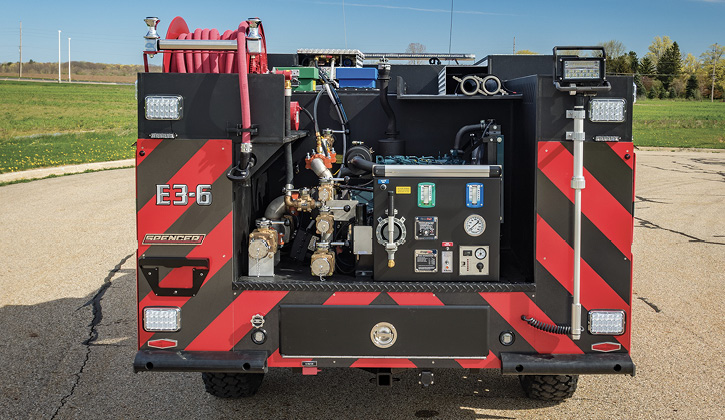
Wildland firefighting may be similar in some ways to structural firefighting, but there are more differences than similarities. Likewise, the apparatus used in wildland firefighting differs too, especially in the setup of wildland apparatus and the types and capacities of the pumps the rigs carry.
TYPE 3 ENGINES
Scott Kiernan, senior project manager for Pierce Manufacturing Inc., says that on Type 3 engines that Pierce builds, it typically installs a 500-gallon-per-minute (gpm) two-stage Darley JMP500 as a midship pump 60 percent of the time and the 1,000-gpm single-stage Darley LSP1000 40 percent of the time. The auxiliary pump installed most often is a Darley 1-1/2AGE pump powered by a 24-horsepower (hp) Kubota diesel engine, he adds. “We’ve also been using the Darley 1-1/2AGH, which we drive through hydraulics,” Kiernan says. “The pump has a pressure control assembly that allows it to maintain pressure as the vehicle moves up in elevation.”
Related Content
- Type 3 and Type 6 Wildland Fire Apparatus
- National Wildfire Coordinating Group Decides to Continue Use of 2002-Designed Fire Shelter
- Type 3 Wildland Apparatus for Colorado Department
Doug Feldman, western region manager for Rosenbauer, says that Rosenbauer has found that many departments like the Darley JMP500 pump or the Waterous CPK 3 two-stage pump on their Type 3 engines, along with a Darley 1-1/2-AGE auxiliary pump. “Some departments prefer the 1,250-gpm Rosenbauer NH1250 multistage pump, which is the pump found on our Timberwolf wildland engine, and also the Rosenbauer HP600 for normal type pressure,” Feldman points out. “Half of all the wildland engines we build have a FoamPro 1600 foam system on them and 20 or 30 gallons of foam, and the other half are set up with an eductor foam system.”
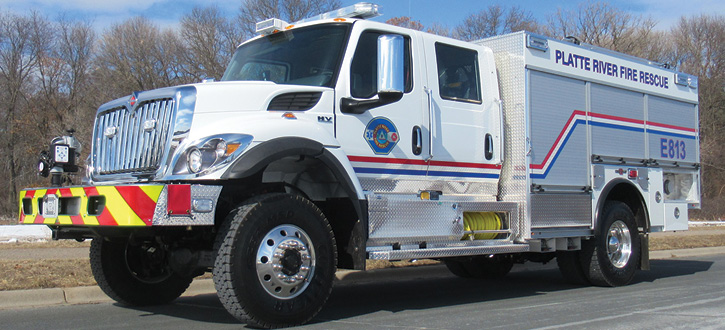
1 Rosenbauer built this Type 3 wildland pumper for the Platte River (CO) Power Authority that carries a Rosenbauer NH-55 1,250-gpm pump and a FoamPro 2002 foam system. (Photo courtesy of Rosenbauer.)
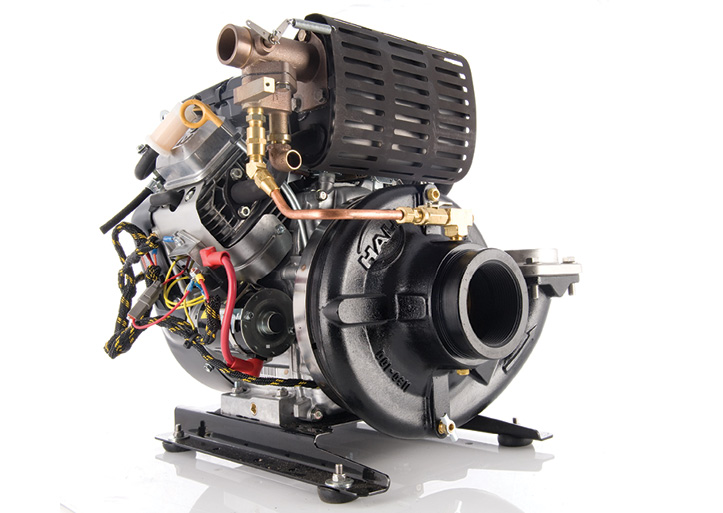
2 The Hale Products HPX200 pump powered by a Briggs & Stratton 18-hp gasoline engine often can be found on Type 5 and Type 6 wildland engines. (Photo courtesy of Hale.)

3 This U.S. Forest Service Model 326/346 built by REV Group has a rear-mount pump panel housing a Hale CBP pump. (Photo courtesy of REV Group.)
Jason Darley, North American sales manager for W.S. Darley & Co.’s pump division, says the Darley JMP500 used on Type 3 rigs puts out 100 gpm at 600 pounds per square inch (psi), while the Darley HSP250 will deliver 100 gpm at 400 psi. “Both are [power takeoff (PTO)] driven pumps, and above the PTO, we mount a Darley 1-1/2AGE auxiliary pump driven by a 24-hp Kubota diesel engine,” Darley says.
Brett Cerini, California sales manager for the REV Fire Group, says that a lot of fire departments look to the U.S. Forest Service, other federal agencies, and CAL FIRE, which are heavy users of Type 3 wildland engines. “Wildland apparatus needs to have a short wheelbase,” Cerini says, “so the Darley JMP500, the Hale CVP rated at 750 gpm, and the Waterous CPK3 two-stage pump with pump-and-roll capability are all good choices because they are compact packages.”
Jon Kostyzak, product manager for Hale Products, says Hale’s TBP500 and TBP750 dual-pressure pumps have been installed on Type 3 engines. “These are twin booster pumps that can be run as high-volume/low-pressure pumps or switched over to low volume/high pressure for wildland firefighting,” Kostyzak says. “So, they can be run as either single- or dual-stage pumps.”
Matthew Wolf, sales manager for Waterous, says that Waterous often sees its CPK3 500-gpm two-stage pump installed on Type 3 rigs, putting out 500 gpm at 150 psi and 250 gpm at 250 psi. “Also, Type 3s might carry a single-stage CPK2 300-gpm pump or a CLVK 500-gpm model,” Wolf says. “For the auxiliary pump, there are four models in the PB18 series, each equipped with an 18-hp Briggs & Stratton V-Twin gasoline engine.”
Chad Moffatt, president of Boise Mobile Equipment (BME), says most of the pumps BME installs on Type 4 wildland engines are the Darley JMP500 and the Darley 1-1/2-AGE auxiliary pump with a 24-hp Kubota diesel engine. “We’ve also used single-stage Darley HSP260 pumps off the PTO on Type 3s,” he adds. “Plus, we make a Type 3 heavy with Darley JMP500 or HSP250 pumps and carrying 750 to 800 gallons of water.”
At HME Ahrens-Fox, Ed Boring, fleet sales manager, says its Type 3 engines usually have a Hale, Darley, or Waterous 500-gpm midship pump and a Darley 1-1/2AGE auxiliary pump, although recently HME Ahrens-Fox has been installing its own AF pump.
TYPE 4 UNITS
Darley notes that many agencies using Type 4 tactical tenders outfit them with Darley HM and HSP pumps. “The HM will deliver between 250 and 500 gpm,” he points out, “while the HSP will put out 250 and 350 gpm. The HSP is unique in that it’s the same pump casing as the HS500 but with an impeller that delivers higher pressure: 100 gpm at 200 psi. It also can be set up for pump and roll, if needed.”
Cerini says that Type 4 engines are very popular in Idaho, Montana, and Wyoming. “They carry 750 to 800 gallons of water and a Darley 1-1/2-AGE, Hale 750, or Waterous 501 pump,” he says.
Moffatt says most its Type 4 engines have Darley JMP500 pumps on them, with some U.S. Forest Service trucks having a bigger horsepower auxiliary pump in the form of a Darley 1-1/2AGE powered by a 34-hp Kubota diesel engine.
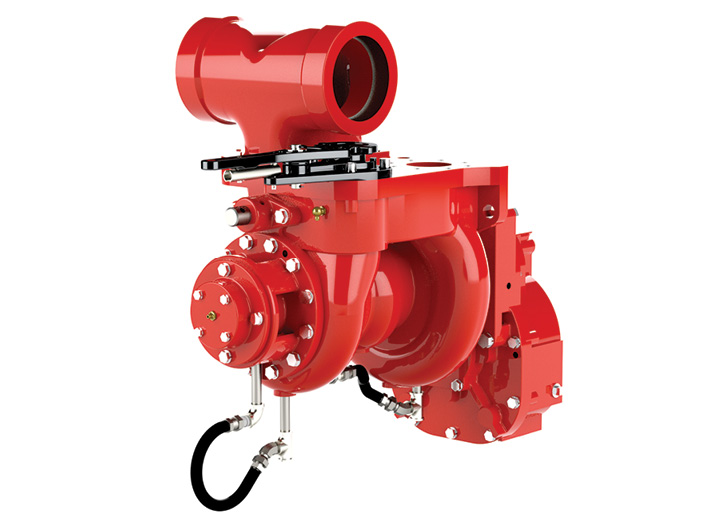
4 The Waterous CPK-3 500-gpm two-stage pump often is installed on Type 3 wildland rigs. (Photo courtesy of Waterous.)

5 Boise Mobile equipment built this Type 3 heavy engine for the Parma (ID) Rural Fire District with a Darley JMP500 pump and an 800-gallon water tank. (Photo courtesy of Boise Mobile Equipment.)
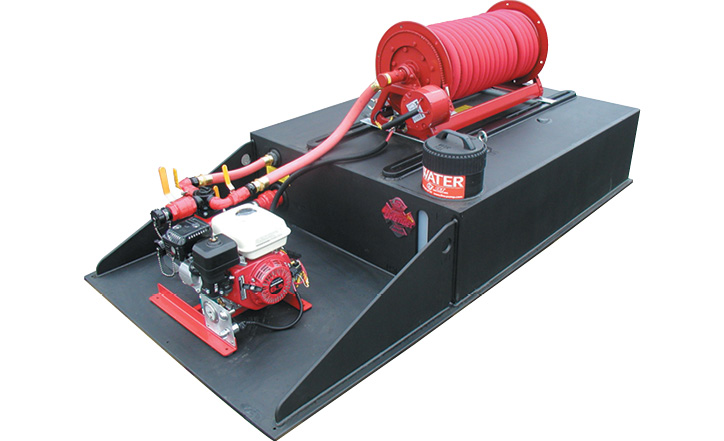
6 CET Fire Pumps makes the PFP HND-M-Twin 6-hp pump with twin impellers that delivers 20 gpm at 125 psi. (Photo courtesy of CET Fire Pumps.)
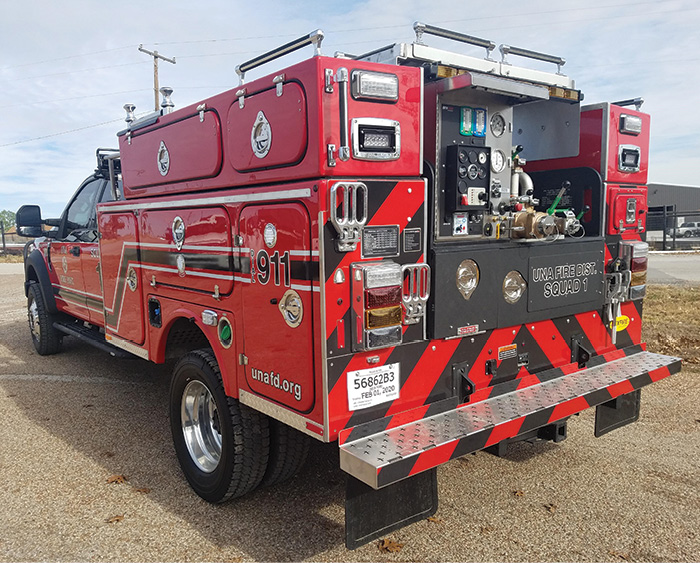
7 For the Una (SC) Fire Department, BFX Fire Apparatus built a Type 6 engine with a 24.8-hp Kubota diesel-driven WATERAX BB-4 pump that delivers 120 gpm at 100 psi. (Photo courtesy of BFX Fire Apparatus.)
On Type 4 engines, Zach Grigg, product specialist for WATERAX, says his company’s BB4 pump has been very popular. “It delivers 106 gpm at 420 psi,” he says, “and can be powered by the Briggs & Stratton 18-hp, 21-hp, and 23-hp gasoline engines or the 25-hp Kubota diesel. Some departments choose the B2X, a midrange pump that delivers 300 gpm at 200 psi.”
TYPE 5 VEHICLES
Cerini notes that a Type 5 engine typically carries 400 gallons of water, “so you have to be careful to make the weight work on a 19,500-pound gross vehicle weight rating. If you’re only putting a pump, a few hoses, and water on it, you’re probably okay, but you won’t have a lot left for hand tools and strike equipment. The Ford F-650 and the Chevy CV are viable options for the Type 5, and in the plains states, they like to put remote-control low-flow bumper turret monitors for cruising along a fire line.”
On Type 5 wildland apparatus, Darley points out that HM250 and HSP250 and 350 pumps are often used.
Mike Weis, owner of Weis Fire and Safety, says all of his company’s Type 5 and Type 6 brush rigs use either Darley or Hale pumps driven by 18- to 35-hp gasoline engines or 24- to 39-hp diesel engines. “But, there are exceptions,” Weis says. “For Los Alamos (NV) Fire Department, we installed a pump driven by a 49-hp engine because of the department’s 7,000-foot-plus elevation.”
Mark Brenneman, assistant sales manager for 4 Guys Fire Trucks, says 4 Guys built a Type 3 style engine on a Freightliner M2 chassis with a Hale 1,500-gpm midship pump and a Hale 100-gpm auxiliary pump for the Clearview (WV) Volunteer Fire Department.
TYPE 6 PUMPERS
Kiernan says Pierce has built a number of Type 6 wildland pumpers, usually carrying a Darley 1-1/2AGE pump powered by a Honda gasoline engine. “Pierce got a Bureau of Land Management contract to build its Model 667 Wildland engine that carries 800 gallons of water,” he says. “The standard pump on half of those engines is a Darley 1-1/2AGE powered by a 48-hp Kubota diesel engine, and the other half have a Darley HSE powered by a 65-hp Kubota diesel and capable of 100 gpm at 330 psi.”
Feldman says that the Type 6 engines Rosenbauer builds are usually on Ford F-550 or F-650 chassis carrying 300 gallons of water and a skid-mounted Darley 1-1/2AGE pump.
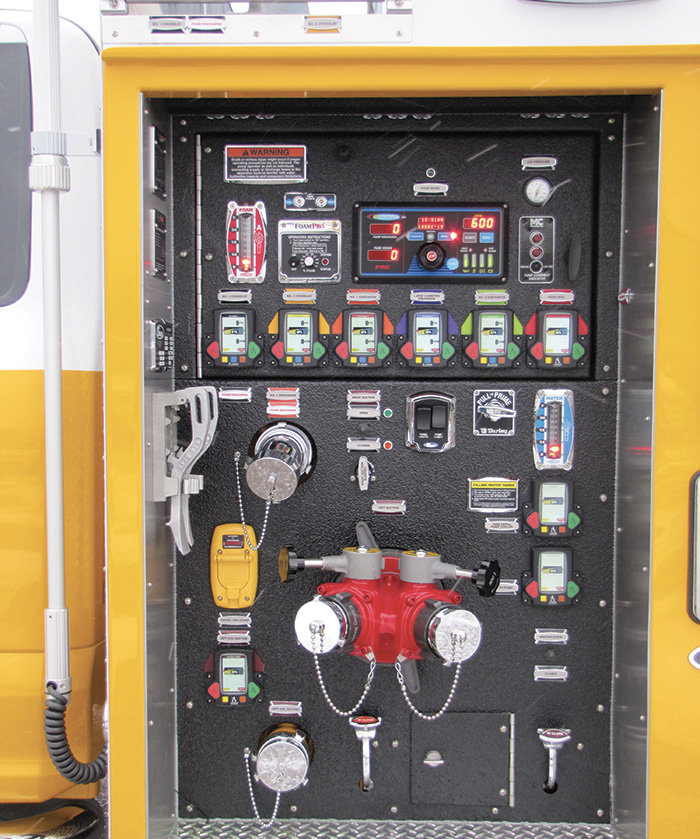
8 The West Bradford (PA) Fire Company had 4 Guys Fire Trucks build it a Type 6 engine with a Darley PSM 1,000-gpm midship pump. (Photo courtesy of 4 Guys Fire Trucks.)

9 Spencer Manufacturing Inc. built this Type 6 wildland engine for the Blackhawk (SD) Fire Department with a Darley 1-1/2AGE pump powered by a 39-hp Kubota diesel engine. (Photo courtesy of Spencer Manufacturing Inc.)
On Type 6 rigs, Darley says his company primarily sees the Darley 1-1/2AGE being used. “We offer it in several gear ratios and two different impellers because some agencies gear it so the pump has better volume performance for auxiliary duties, while others set it up with solely wildland in mind and use higher pressures and less water,” Darley notes.
Justin Wilbur, OEM account manager at Hale Products, says the Hale pump of choice on a Type 6 usually depends on the geographic location of the rig. “In the west, where there is high terrain, the Hale HP75 high-pressure/low-volume pump is often chosen where they have to push water over long lengths and up elevations,” Wilbur points out. “The pump would be powered by a Briggs & Stratton gasoline engine of either 18 or 23 hp or a Kubota 24-hp diesel engine.”
In the Midwest, Wilbur observes that for Hale, “The pump of choice is the Hale HPX200, a medium-pressure, medium-volume pump powered by an 18-hp or 23-hp Briggs & Stratton gasoline engine or a 24-hp Kubota diesel. We’ve also used a 20-hp Honda gasoline engine that’s popular in the Dakotas, Minnesota, Michigan, and Wisconsin because it has a little better cold starting power.”
For Type 6 wildland engines, Wolf says that he’s seen compressed air foam systems (CAFS) being installed. “We have the 70-35GP slide-in, portable CAFS system that delivers 70 gpm of water at 100 psi and 35 [cubic feet per minute (cfm)] of air at 100 psi of foam discharge up to 130 psi,” he says. “We also have the 200-50-DS and the Eclipse™ GEN 2.0 Model 100-50-ECL.”
Perry Shatley, wildland sales manager for BFX Fire Apparatus, says, “The vast majority of the Type 6 pumpers we build use gasoline-driven pumps, usually a Darley 1-1/2AGE or a Waterax BB4 with a Briggs & Stratton engine. We also are running these pumps hydraulically now using a Harrison Hydra-Gen hydraulic generator that gives pristine pump and roll, whether stationary or at three miles an hour. We also have a chassis that gives us live PTO, where as long as the truck is running, it will give tremendous pressure and gpm and isn’t affected by elevation like gasoline and diesel engines.”
Todd Nix, apparatus consultant for Unruh Fire, says Unruh uses a wide variety of pumps on the wildland engines it builds. “The Hale HPX200 powered by a Briggs & Stratton 18-hp gasoline engine is very popular, as are the Darley 2BE 18V and the Darley 1-1/2-AGE,” Nix points out, “and also the Hale HPX75 that gives 150 gpm at 375 psi, so it has a lot more penetration.” Nix says Unruh built a Type 6 for the Carroll Township (PA) Fire Department with a Hale HPX300 B18 pump for volume and a Delta 100 diaphragm pump powered by an 18-hp Briggs & Stratton Vanguard gasoline engine for pressure that puts out 26 gpm at 560 psi.
Jerry Halpin, vice president of sales and marketing for CET Fire Pumps, says CET makes a forestry pump used on Type 6 trucks that’s powered by an 11-hp Honda gasoline engine that develops 70 gpm at 10 psi, 40 gpm at 100 psi, and 20 gpm at 125 psi. CET’s PFP-6hp HND-M-Twin fire pump with twin impellers will deliver 20 gpm at 125 psi, Halpin says.
Moffatt notes that BME generally will put a Darley 1-1/2AGE with a 24-hp Kubota diesel engine on its Type 6 engines, although some are outfitted with Perkins 32-hp diesel engines.
Brenneman notes his company built a Type 6 for the West Bradford (PA) Fire Company on a Ford F-550 chassis carrying a Darley PSM1000 PTO-driven midship pump.
Joe Messmer, president of Summit Fire Apparatus, points out that Summit uses a variety of pumps on its Type 6 rigs depending on the customer’s needs and wants. Messmer says the Darley 2-1/2-AGE is a favorite, but Hale and CET pumps also are popular.
Ben Bregg, design engineer at Spencer Manufacturing Inc., says Spencer uses “a lot of Darley and Hale portable pumps on our brush trucks, like the Darley 2BE 21H, Darley 2BE 24K, and Hale HP200 and HP75.”
Grigg says the BB4 pump is used on Type 6 pumpers with the same engine configurations as on Type 4 apparatus. For Type 7 engines, WATERAX typically supplies its VERSAX, Striker 2, or Striker 3 models of pump.
Jamie Emblem, U.S. sales for the Northeast at Mercedes Textiles Ltd., notes his company makes the Wick® 100-4H pump powered by a four-stroke 50-cc Honda gasoline engine that’s used on Type 6 rigs. “We also have had our 250si and 300si pressure pumps put in skid units on Type 6 trucks,” he says, “as well as the Wick F200 two-stage pump and the Wick 4200-23 four-stage pump.”
ALAN M. PETRILLO is a Tucson, Arizona-based journalist, the author of three novels and five nonfiction books, and a member of the Fire Apparatus & Emergency Equipment Editorial Advisory Board. He served 22 years with the Verdoy (NY) Fire Department, including in the position of chief.

